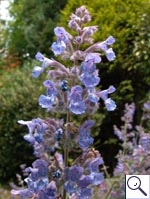|
||||||
|
NEPETA. Cat-mint. [Lamiaceae] |
|
|
Four species of Nepeta are recorded in Britain. These include the native Cat-mint (N. cataria) and the introduced Garden Catmint (N. nepetella). Five British miners are recorded on Nepeta. A key to the European miners recorded on Nepeta is provided in Bladmineerders van Europa. |
 Garden Catmint Nepeta nepetella |
Key for the identification of the known mines of British |
| 1a > Stem miner: A shallow, inconspicuous external stem mine. Pupation in stem near a node (Spencer, 1972b: 29). |
|
Ophiomyia labiatarum Hering, 1937 [Diptera: Agromyzidae]. |
1b > Leaf-miner and case-bearer: Blotch mines reaching the edge of the leaf, initially pale green turning brownish white, are caused by the larva feeding on the underside of a leaf. The fully developed case is slender, shining black brown, about 9 mm long. Towards the end a narrow, transparent yellowish ventral keel. Mouth angle 50-60°. Cases on the leaf underside. |
|
Coleophora albitarsella Zeller, 1849 [Lepidoptera: Coleophoridae]. |
1c > Leaf-miner: A distinctive mine primarily above mid-rib, with irregular short lateral offshoots into leaf blade. Pupation external (Spencer, 1972: 51 (fig. 172), 55; Spencer, 1976: 270, 271 (fig. 486)). Branched, whitish, upper-surface corridor; main axis overlying the midrib; side branches overlying the main lateral veins. (In Campanula and Phyteuma the mine is much less branched, sometimes nothing more than a corridor on top of the midrib). Frass in rather long strings. Usually the mines begins as a long and narrow, shallow, tortuous lower-surface corridor that ends upon the midrib but otherwise is not associated with the leaf venation. Often this initial corridor is filled with callus, and then even less conspicuous. Pupation outside the mine. A linear mine on the upper surface, usually following the midrib and showing side branches along the veins. The frass is in strings. |
|
Liriomyza strigata (Meigen, 1830) [Diptera: Agromyzidae]. |
1d > Leaf-miner: Mine linear, whitish, both upper and lower surface. Pupation internal, at the end of the mine with the anterior spiracles projecting through the epidermis (Spencer, 1976: 433). Upper-surface, less often lower-surface corridor. Frass in isolated grains. Pupation within the mine, usually in a lower-surface puparial chamber. A long whitish upper surface corridor, which eventually goes lower surface. |
|
Chromatomyia horticola (Goureau, 1851) [Diptera: Agromyzidae]. |
1e > Leaf-miner: Mine beginning with a small spiral, later developing into a greenish blotch, brown when old. Pupation frequently in mine (Spencer, 1972b: 90). The mine, that may be upper- or lower-surface, generally starts with a tight spiral. Its loops are so tight that the leaf tissue dies off and turns red; nevertheless the corridor remains well visible. Later the corridor widens and finally a large secondary blotch develops around the initial spiral. Frass at first in two rows of grains, later in pearl chains. Feeding lines very clear. Pupation now within, then outside the mine. |
|
Phytomyza obscura Hendel, 1920 [Diptera: Agromyzidae]. |
| Last updated 06-Jul-2019 Brian Pitkin | ||
